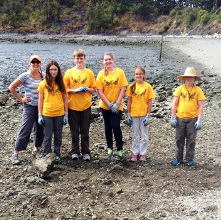–by Katarina Schiller, Maya Heikinnen and Taylor Morrison with Trillium Swanson, Crew Leader —
[metaslider id=38127]
The Orcas Island Youth Conservation Corps recently spent three days working on fish habitat restoration projects with Tina Whitman, Science Director for Friends of the San Juan. The first day we worked at West Beach Creek, where we weeded, watered, and mulched around the recently planted native plants in the restoration project. A driveway had dammed up the creek and created a pond, which destroyed fish habitat. Now a large culvert has been placed in the creek to allow a more natural flow of water. Tina also explained about how all 5 species of native salmon use creeks like this for this, as the young fish travel from rivers out to the ocean. We also talked about native trees, and how to identify them.
The next week we spent two days out on Sucia Island. The first day we worked on restoring some forage fish habitat, by moving non-native rock off a potential spawning beach in Fossil Bay. The sandstone on the beach came from the nearby sandstone quarry, and was spilled here when sandstone was taken off the island. We carried that off the beach to leave sands and beach cobbles. We also walked several beaches in Fossil Bay and Fox cove to pick up garbage, and we saw lots of cool fossils embedded in the rock.
We began the next morning with a bumpy boat ride back to Sucia, and saw two porpoises swimming as we got there. We brought some dip nets to try to catch some of the little fish we saw off the dock. We put them in a bucket of water so we could identify them. We saw herring, a sand lance, and some shiner perch. Then we listened to the Park Ranger talk about the geology of Sucia Island. The sandstone is from the Chuckanut formation and matches the rock of the Chuckanut range near Bellingham. The rock with the fossils on the south side of the island is from the Nanaimo formation. He also talked about the theropod femur bone fossil that was found on Sucia, and told us this was the first and only dinosaur fossil found in the state of Washington.
The rest of the day we did forage fish surveys to try to find Surf smelt eggs. We gathered scoops of sand and gravel near the high tide line, then filtered the gravel though mesh filter, so we could see if there were any eggs. We didn’t find any, but Tina will look at the samples again in the lab.
From these surveys we learned much about fish spawning, different characteristics of beaches, and the process of separating fish eggs from the sand. We also learned that forage fish enjoy spawning in sandy and pebbly areas. When we cleared large rocks from the beaches we helped to maintain this habitat for the forage fish.
**If you are reading theOrcasonian for free, thank your fellow islanders. If you would like to support theOrcasonian CLICK HERE to set your modestly-priced, voluntary subscription. Otherwise, no worries; we’re happy to share with you.**








